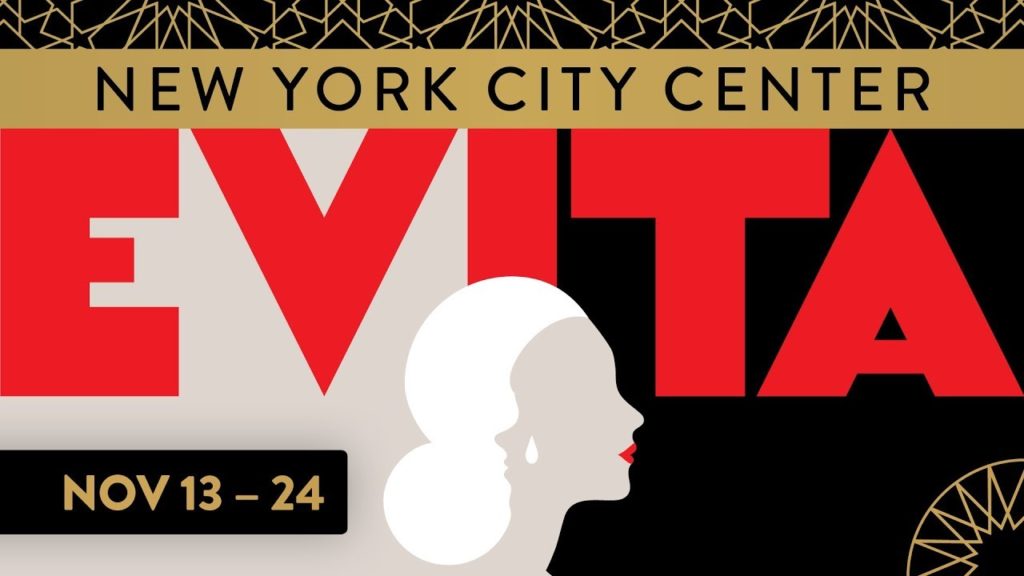 City Center’s Gala Presentation of Evita is full of fascinating ideas from white-hot (and young!) director Sammi Cannoid. The buzziest of these is separating the title role in two: Young Eva (Maia Reficco) and Eva (Solea Pfeiffer). Cannoid ‘s choice highlights the age gap between the 15-year-old Eva Duarte and the 36-year-old crooner Agustín Magaldi (Philip Hernåndez). Cannoid challenges the conventional narrative of Eva’s early string of “lovers” (“What a manipulative slut!”) and confronts the audience with the reality that Eva is a survivor of numerous incidents of sexual violence.
City Center’s Gala Presentation of Evita is full of fascinating ideas from white-hot (and young!) director Sammi Cannoid. The buzziest of these is separating the title role in two: Young Eva (Maia Reficco) and Eva (Solea Pfeiffer). Cannoid ‘s choice highlights the age gap between the 15-year-old Eva Duarte and the 36-year-old crooner Agustín Magaldi (Philip Hernåndez). Cannoid challenges the conventional narrative of Eva’s early string of “lovers” (“What a manipulative slut!”) and confronts the audience with the reality that Eva is a survivor of numerous incidents of sexual violence.
This choice largely works and gives the audience a greater sense of the character’s arc from poverty to power. It was especially lovely to hear “Another Suitcase in Another Hall” be turned into a trio with Juan Peron’s unnamed Mistress (Maria Cristina Slye) and the two Evas. However, Cannoid makes the strange choice to switch the Evas very early in the show. Young Eva doesn’t even get to finish her big number, “Buenos Aires” before aging into (old?) Eva. It’s as if simple contact with the city, transforms her into a grown woman. Frustratingly, there are quite a few places to insert the transition in the next scene that would have made more of a dramaturgical impact.
I have always found Che to be the show’s most problematic character. Here, Che (Jason Gotay) is smartly conceived of as an extra-textual narrator that sometimes functions as a Greek chorus. He occasionally inserts himself into the action of the play, but he mostly provides a (contemporary) cynical, anti-Peronist point of view. This works better than the wildly ahistorical portrayal of him as Che Guevara or making him a descamisado (working-class Argentinian). For me, neither of these interpretations work as he largely seems to serve as the mouthpiece for the shows British creators. They don’t seem to think much of Evita Peron or the people who saw her as a path toward salvation and social justice.
This empathy for the descamisados and Eva is where the City Center production seems to challenge the text. In a recent TEDx talk, Cannoid asserts that Evita was meticulously researched by its creators. However, she says, historical perspectives change. Evita is a product of a certain time and place. Andrew Lloyd Webber and Tim Rice, while invested in historical accuracy, were surely not interested in challenging their own Euro-centric or misogynistic gaze. Musically and lyrically, Argentine references and motifs are superficial at best, culturally incompetent at worst. Perón, Eva, and Magaldi are the only historical characters given names. Evita, as written, fails to show us how we might understand these figures in a social context.
So what does our current cultural context bring to Evita? That Evita’s pageant-like rise to fame was born out of the traumas of poverty and sexual abuse. That when we look at the volatile political situation she stepped into, let’s remember the complicated international politics of the time. After all, how many atrocities have been done by the hand of US and European foreign policy in Latin America? This might be the closest we’ll get to a Marxist and Feminist reading of Evita. I’m just not sure the text, written outside a post-colonial and feminist lens, can justify it.
[New York City Center, 131 W 55th St, New York, NY] November 12-24, 2019; nycitycenter.org
